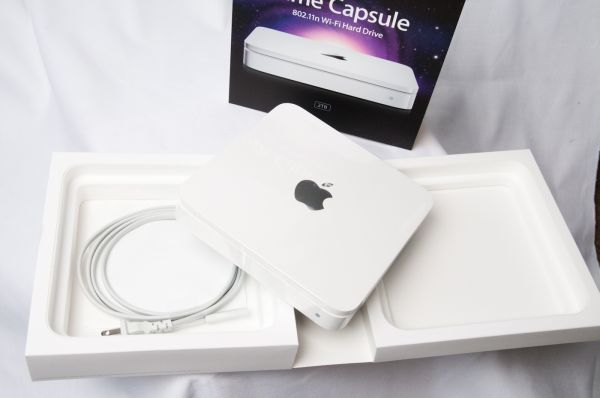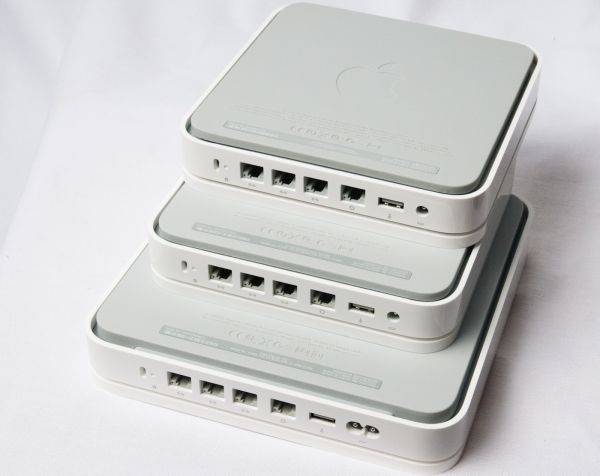Airport Extreme (5th Gen) and Time Capsule (4th Gen) Review - Faster WiFi
by Brian Klug on August 5, 2011 10:22 PM EST- Posted in
- Mac
- Airport Extreme
- Time Capsule
- WiFi
Apple has been playing it cool on the WiFi side of things lately. It started with the previous Airport Extreme (Gen 4) which quietly introduced three spatial stream support, followed up by the Early 2011 MacBook Pro update which brought a three spatial stream compliant WLAN stack, and now has continued with an even more understated update for the Time Capsule (4th generation) and Airport Extreme (5th generation).
Both updates launched just prior to this latest round of Apple launches, which included the Mac Mini, Macbook Air, and Thunderbolt Display, but unlike those three, the Time Capsule and Airport Extreme updates saw almost no mention. Starting with the exterior packaging, you’d be hard pressed to tell that a particular Time Capsule or Airport Extreme is the newer refresh. I no longer have the old Airport Extreme packaging, but the new device box is virtually indistinguishable. Outside of bumping the supported storage capacity for the Time Capsule up to 3TB, there’s no real obvious giveaway for the Time Capsule either.
The only way to tell which version is which by looking at the box is by the model numbers—MD031LL/A for the 5th generation Airport Extreme, and MD032LL/A for the 2TB 4th generation Time Capsule.
The contents of the Airport Extreme box remain the same as well, starting with the device itself on top, and underneath it, a power cable, 12 volt power supply (model A1202) and some literature about setup in a white plastic bag.
The Time Capsule box is much the same affair, with the device inside, a power cable, no power supply (since it’s internal), and some literature.
I stacked all three devices up so you can compare physically. Really the only big giveaway between the two Airport Extremes is an extra line of text on the previous generation, and of course the model number or FCC ID. Both the Time Capsule and Airport Extreme still retain the same port configuration—four GigE ports, one USB 2.0 port, power, reset, and a Kensington security slot. Those four gigabit ethernet ports can either be used as a switch, or you can use the device as a router and then the leftmost port becomes WAN and the right three become LAN.
At this point it isn’t really looking like there’s much different, but exterior appearances can be deceptive.




















90 Comments
View All Comments
Brian Klug - Sunday, August 7, 2011 - link
Yeah, I should note that right now idle seems to be around 8-9 watts without much change.-Brian
jalin2 - Monday, August 8, 2011 - link
I'm in the market to get a new router and was set on getting the E4200. Now I think I'm going to hold off and wait until your router comparison article. Any idea on timeframe when that'll be released?jackwong - Sunday, August 14, 2011 - link
I would rather go with Apple, the only good Linksys router I have is the WRT54. I also have the e2500 few months ago, I can't believe a 2011 router doesn't has gigabyte ports... and it has connection problem everyday...I would rather go with Apple Extreme base station unless the e4200 is way cheaper.
melgross - Monday, August 8, 2011 - link
I've had a lot of Linksys routers over the years, stupidly, because every one died. That includes some commercial models. I will NEVER use another Linksys product again.I've got one Extreme, and two Expresses, and have never had a problem with them. As the review says, they just work.
I've got an old house, built in 1925. Most interior walls are brick. All the walls and ceilings have .75" wood over the brick, with gal steel mesh over that, with .75" mortar, and a .25" layer of plaster over that. The damn thing is as close to a Faraday cage as anyone will ever live in. I've removed some of that when re-doing the kitchen and downstairs bathroom as well as the two bathrooms upstairs by having everything stripped to the beams and replaced with double .5" Sheetrock, but still...
Guspaz - Monday, August 8, 2011 - link
Perhaps some mention should be made of the fact that Apple advertises the drive in the Time Capsule as a "server-grade hard drive".You do mention that it's very much a consumer disk (in fact, the most "consumer" you can get since it's not even a black or RAID edition), but Apple is really billing the thing as server-grade, which is false advertising.
jwoelich - Monday, August 8, 2011 - link
"Fortunately, a source inside Western Digital was willing to explain matters; "If you enter in the drive number on NewEgg you're going to see it come up as a desktop drive. That platform is actually built on a lot of other products for a lot of different OEMs. And the specs could change depending on whatever program we're building for. Needless to say Apple has very stringent requirements that are very specific to them and very unique to them, and that drive has actually been developed and is unique for that Apple product. That unique Apple logo, and what we call 'to the right of the dash,' if you will, indicate that this drive is for a very particular partner to us and this drive is dedicated to that particular audience. You could not buy this same drive at NewEgg or Amazon."When we asked whether the variation of the WD20EARS drive is rated for a 1-million-hour MTBF, our source confirmed that it was: "We don't spec our desktop drives with MTBF because our customers don't purchase in that manner, but this particular drive for this particular OEM with these unique requirements does meet those specifications."
Western Digital says otherwise.
repoman27 - Monday, August 8, 2011 - link
lowlymarine did mention it in a comment two days ago, to which I pointed out that for price per GB and performance per watt the Caviar Green is tough to beat, and therefore perfect for servers. Just considering how many Google uses, I would be surprised if there is another line of drives more deployed in servers at the moment than Caviar Green.Not all "servers" are designed for crazy amounts of IOPS, massive queue depths, or incredibly high availability. For backup or redundancy, which is what the Time Capsule is marketed for, you want big, cheap and low-power.
No offense, jwoelich, but although the quote may be legitimate, I have a seriously hard time buying that line of utter crap. We're pretty much down to a three horse race in the storage arena, and just like Intel or AMD might bin things differently or cater to large OEMs in various ways, they basically just pump out a small range of identical products by the millions. There are no "magical drives" that are perfect for servers but not sold by Newegg. The way I read it, Apple had a very stringent range of specifications, to which a bog standard Caviar Green drive happens to adhere perfectly (i.e. low price per GB and low power requirements.)
jwoelich - Tuesday, August 9, 2011 - link
I don't see where anyone stated anything being 'magical', just that if you were to go onto Newegg, you couldn't just order one of these specific drives. Now, does that mean that there is more to it than Western Digital simply taking any WD Green drive, testing it to conform with the criteria set forth by Apple, then throw on a new sticker? Or did WD design/modify a product specifically to meet that criteria? More likely, WD crafted a Frankendrive using the criteria Apple set forth, and used the bare minimum of higher quality components that would more likely ensure that criteria was met, which was probably nothing more than power consumption, size, speed and a greater MTBF.LoneWolf15 - Monday, August 8, 2011 - link
"Some more searching revealed the solution—pin 20 (wireless disable) needs to be taped over to signal the card that the wireless disable switch (which doesn’t exist, since this is the WAN port) is in the on position. A quick surgical application of tape, and the card worked perfectly—take that, Lenovo security. As an aside, what a completely pointless and trivial barrier this is—the Mini PCIe standard (and moreover WiFi notebook cards themselves with U.FL connectors) are designed to be completely and absolutely interchangeable. The notion that this provides any added security (when the adjacent slot is completely unguarded) or—even more absurd, convenience—is nothing short of a surrealist notion."Lenovo isn't the only one. HP also does the exact same thing; they whitelist cards in the BIOS, so that only their branded version of Intel's (or Broadcom's) wireless cards work.
I don't think security has anything to do with it. I think two factors are involved --1) that they don't want to support any other wireless cards than their own, and 2) that they want you to buy from them, establishing vendor lock-in.
Dug - Monday, August 8, 2011 - link
There are also modified BIOS' out there that disable the whitelist which is a lot easier than trying to tape a small pin.If the laptop has a 2nd pci slot, which is usually reserved for wlan card, you can use this for the wireless card becuase the BIOS doesn't look at that slot.